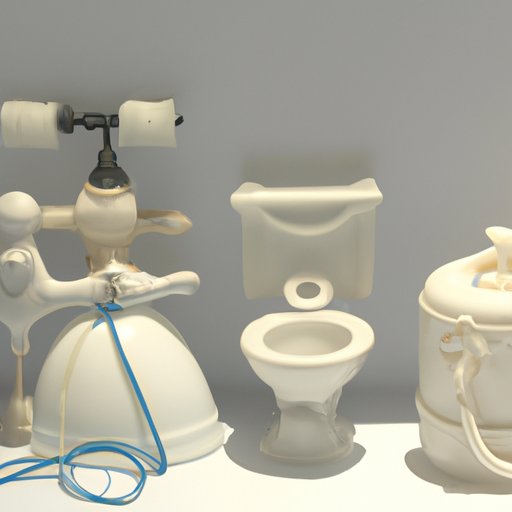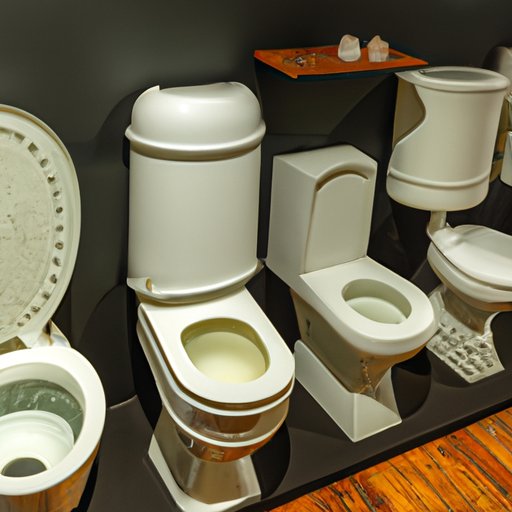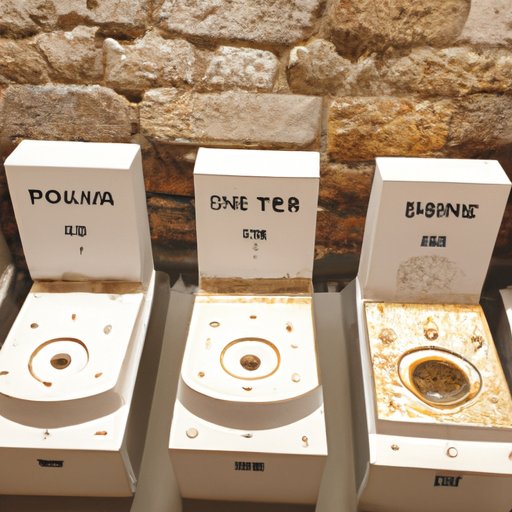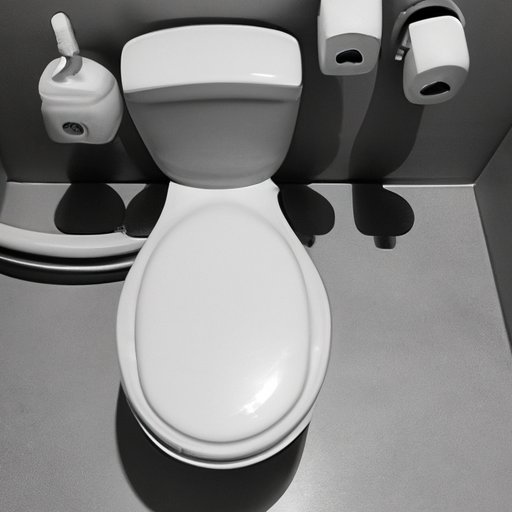Introduction
The invention of the toilet is one of the most important and influential developments in human history. Toilets have revolutionized sanitation and hygiene practices, leading to improved health outcomes for people around the world. But when was the first toilet invented? This article will explore the long history of human waste disposal, from ancient times to the present, and examine the evolution of toilets through the ages.

A Timeline of Toilet Invention: From Ancient Times to the Present
Toilets have been around since ancient times, although they have changed significantly over the centuries. Early evidence of toilets dates back to the Indus Valley Civilization, which flourished in what is now Pakistan and India during the Bronze Age (2500-1500 BC). According to archaeological evidence, these early civilizations had sophisticated plumbing systems that included drainage systems and primitive flush toilets.
The earliest known flush toilets were found in the ruins of the Palace of Knossos on the Greek island of Crete. These toilets, which date back to 2000 BC, used a simple flushing system to dispose of waste. The Romans also made significant advances in plumbing and sanitation, and by the 1st century AD, public toilets were common throughout the Roman Empire.
Modern toilets began to appear in Europe during the 16th century. During this period, indoor plumbing became more commonplace, and the first flush toilets were installed in palaces and mansions. By the late 17th century, flush toilets had become popular among the wealthy classes in Europe. The first public toilets were also established during this time.
In the United States, the first flush toilets were installed in homes in the mid-1800s. By the turn of the 20th century, indoor plumbing had become commonplace, and modern toilets had become standard fixtures in most households.

The History of Toilets: How They Developed Over Time
Toilets have come a long way since their invention thousands of years ago. Ancient toilets used a variety of different technologies, including simple bucket systems and elaborate flush systems. Ancient Greeks and Romans used clay piping to construct rudimentary plumbing systems, and many of these systems were still in use until the 19th century.
During the Middle Ages, toilets became more advanced, with the introduction of wooden seats and stone basins. These toilets were often connected to sewers or cesspools, which were used to collect and dispose of waste. During the Industrial Revolution, sanitation reforms led to the widespread adoption of modern toilets and plumbing systems.
Today, toilets are much more sophisticated than their ancient counterparts. Modern toilets use a variety of technologies, including water-saving features and self-cleaning mechanisms. Toilets have come a long way since their invention, and they continue to evolve as new technologies are developed.
Toilet Technology: From Ancient Flush Systems to Modern Day Commodes
Toilets have changed significantly since their invention thousands of years ago. While early toilets used simple bucket systems, modern toilets use a variety of technologies to make them more efficient and hygienic. Some of the most common technologies used in modern toilets include water-saving features, self-cleaning mechanisms, and automatic flushing systems.
Ancient flush systems used a variety of materials, including clay pipes, wooden troughs, and stone basins. These systems relied on gravity to move waste through the plumbing system. During the Industrial Revolution, more sophisticated flush systems were developed, including the S-trap and P-trap systems. These systems used valves to prevent odors from escaping and to keep water levels in the bowl consistent.
Today, most toilets use a combination of water pressure and gravity to move waste through the plumbing system. Toilets also use a variety of sensors and valves to ensure that waste is disposed of quickly and efficiently. Modern toilets also feature self-cleaning mechanisms and other features designed to improve hygiene and efficiency.

An Exploration of the Evolution of Toilets Through the Ages
Toilets have evolved significantly since their invention, and they have had a profound impact on human health and well-being. Ancient civilizations used a variety of techniques to dispose of waste, including elaborate plumbing systems and primitive flush systems. The Romans also made significant advances in sanitation, and by the 1st century AD, public toilets were common throughout the Roman Empire.
During the Middle Ages, toilets became more advanced, with the introduction of wooden seats and stone basins. These toilets were often connected to sewers or cesspools, which were used to collect and dispose of waste. During the Industrial Revolution, sanitation reforms led to the widespread adoption of modern toilets and plumbing systems.
Today, toilets are much more sophisticated than their ancient counterparts. Modern toilets use a variety of technologies, including water-saving features and self-cleaning mechanisms. Toilets have come a long way since their invention, and they continue to evolve as new technologies are developed.
How Toilets Changed the World: A Look at the Long History of Waste Disposal
Toilets have had a profound impact on human health and well-being. Improved sanitation and hygiene practices have led to reduced rates of disease and increased life expectancy. Toilets have also had a positive impact on the environment, reducing water pollution and improving public health.
Toilets have also changed the way we interact with each other. Before the invention of the toilet, waste was disposed of in public spaces, which could be unsanitary and unpleasant. With the invention of the toilet, waste became a private matter, and it allowed people to maintain a greater sense of privacy and dignity.
Toilets have also played an important role in social reform. In the 19th century, sanitation reforms led to the widespread adoption of modern toilets and plumbing systems. These reforms had a profound impact on public health, and they helped to reduce disease and improve quality of life.
Who Invented the Toilet? A Study of the Pioneers Behind This Crucial Invention
The invention of the toilet can be attributed to several individuals throughout history. One of the earliest inventors of the modern toilet was Alexander Cummings, who patented a design for a flushing toilet in 1775. John Harington, an English courtier and inventor, is also credited with inventing the first functional toilet. In 1596, he published his design for a “water closet”, which featured a valve and bowl.
Thomas Crapper is another important figure in the history of the toilet. He was an English plumber who improved upon existing designs and developed numerous innovations, including the U-bend trap and the ballcock mechanism. His company, Thomas Crapper & Co., was one of the first companies to mass-produce toilets.
Conclusion
The invention of the toilet has had a profound impact on human health and well-being. Toilets have revolutionized sanitation and hygiene practices, leading to improved health outcomes for people around the world. This article has explored the long history of human waste disposal, from ancient times to the present, and examined the evolution of toilets through the ages. From ancient flush systems to modern day commodes, toilets have come a long way since their invention, and they continue to evolve as new technologies are developed.
The pioneers behind this crucial invention have also been discussed. Alexander Cummings, John Harington, and Thomas Crapper are all credited with making significant contributions to the development of the modern toilet. Their inventions have played an important role in improving sanitation and hygiene practices, and their legacy will live on for generations to come.
(Note: Is this article not meeting your expectations? Do you have knowledge or insights to share? Unlock new opportunities and expand your reach by joining our authors team. Click Registration to join us and share your expertise with our readers.)
